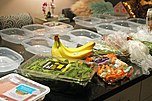| Part of a series on |
| Meals |
|---|
 |
| Meals |
| Components and courses |
| Related concepts |
Meal preparation, sometimes called meal prep, is the process of planning and preparing meals while pre-packaging the meals to be eaten throughout the week.
Advance preparation

Meal preparation involves preparing meals ahead of time. This practice may occur among people who desire to lose weight, gain muscle mass, or maintain a healthy lifestyle. Advance preparation can serve to standardize food portions. Prepared meals are fully cooked. Meals may be prepared in small containers such as Tupperware, and are sometimes labeled and dated to remain organized.
Benefits
Saving money
By preparing meals in advance, there is a limited need for an individual to purchase food from restaurants or bars, which can have an average markup rate of around 300%. According to the 2020 Consumer Expenditures Report from the Bureau of Labor Statistics, there was a 32.6 percent decrease in spending of food away from home from 2019 to 2020 and, simultaneously, there was a 6.4 percent increase in spending in food at home (which is defined as food at grocery stores and other food stores where the final purchaser is the consumer.) These trends can be attributed to the rise of the COVID-19 during this period as consumers were more hesitant to eat out at this time. The rise in spending for food at home and decrease for food away from home means people were preparing more food at home. Which led to the average consumer saving approximately $1151 from eating out less from 2019 to 2020.
Healthy eating
By using fresh, healthy ingredients as opposed to eating out or consuming a higher volume of processed foods, meal preparation provides numerous health benefits over eating outside of the home frequently. For example, multiple studies have shown that those who consume meals that were prepared at home more often had a significantly lower risk of acquiring type 2 diabetes mellitus. On the contrary, those who meal prep less and eat out more and consume more processed foods have seen to have a significantly higher risk of getting conditions such as hypertension, dyslipidemia, or cancer. Studies have also shown that individuals who eat more meals out, consume a significantly higher amount of sugar and fat and a significantly lower amount of important micronutrients such as iron, calcium and vitamin C.
See also
- List of cooking techniques
- Meal delivery service
- Microwave oven
- Multicooker
- Outline of food preparation
- Quarantine mealprep
 Food portal
Food portal
References
- Pare, J. (2000). Make-Ahead Meals. Company's Coming. Company's Coming Publishing, Limited. ISBN 978-1-895455-72-4. Retrieved May 6, 2015. 157 pages.
- "A Beginner's Guide to Once a Week Food Prep + 20 Starter Recipes and Meal Prep Ideas - Organize Yourself Skinny". Organize Yourself Skinny. 2014-10-24. Retrieved 6 May 2015.
- "How to Price Your Restaurant Menu". Funding Circle. 2019-11-19. Retrieved 2021-09-23.
- "Spending on 9 of the 14 major components of household spending decreased from 2019 to 2020 : The Economics Daily: U.S. Bureau of Labor Statistics". www.bls.gov. Retrieved 2021-09-23.
- "U.S. Food Expenditures at Home and Abroad". www.fb.org. Retrieved 2021-09-23.
- "Consumer Expenditure Surveys Tables (CEX)". www.bls.gov. Retrieved 2021-09-23.
- Polak, Rani; Tirosh, Amir; Livingston, Barbara; Pober, David; Eubanks, James E.; Silver, Julie K.; Minezaki, Kaya; Loten, Roni; Phillips, Edward M. (2018-09-14). "Preventing Type 2 Diabetes with Home Cooking: Current Evidence and Future Potential". Current Diabetes Reports. 18 (10): 99. doi:10.1007/s11892-018-1061-x. ISSN 1539-0829. PMID 30218282. S2CID 52278193.
- Zong, Geng; Eisenberg, David M.; Hu, Frank B.; Sun, Qi (2016-07-05). "Consumption of Meals Prepared at Home and Risk of Type 2 Diabetes: An Analysis of Two Prospective Cohort Studies". PLOS Medicine. 13 (7): e1002052. doi:10.1371/journal.pmed.1002052. ISSN 1549-1277. PMC 4933392. PMID 27379673.
- Fiolet, Thibault; Srour, Bernard; Sellem, Laury; Kesse-Guyot, Emmanuelle; Allès, Benjamin; Méjean, Caroline; Deschasaux, Mélanie; Fassier, Philippine; Latino-Martel, Paule; Beslay, Marie; Hercberg, Serge (2018-02-14). "Consumption of ultra-processed foods and cancer risk: results from NutriNet-Santé prospective cohort". The BMJ. 360: k322. doi:10.1136/bmj.k322. ISSN 0959-8138. PMC 5811844. PMID 29444771.
- Lachat, C.; Nago, E.; Verstraeten, R.; Roberfroid, D.; Camp, J. Van; Kolsteren, P. (2012). "Eating out of home and its association with dietary intake: a systematic review of the evidence". Obesity Reviews. 13 (4): 329–346. doi:10.1111/j.1467-789X.2011.00953.x. ISSN 1467-789X. PMID 22106948. S2CID 42613254.
Further reading
- Foods and Meal Preparation
- Kitchen Afloat
- Meal Preparation as a Family Therapy Intervention
- A Guide to Meal Management and Table Services' 2004 Ed.
- Planning Related to Meal Preparation
- Space Allowances for Meal Preparation and Service in the Southern Rural Home
- "A Value-Added Approach to Household Production: The Special Case of Meal Preparation". jstor.
- Ortiz, Bonnie; MacDonald, Maurice; Ackerman, Norleen; Goebel, Karen (1981). "The Effect of Homemakers' Employment on Meal Preparation Time, Meals at Home, and Meals Away from Home". Home Economics Research Journal. 9 (3): 200–206. doi:10.1177/1077727X8100900303.
- Candel, M.J.J.M. (February 2001). "Consumers' convenience orientation towards meal preparation: conceptualization and measurement". Appetite. 36 (1): 15–28. doi:10.1006/appe.2000.0364. PMID 11161342. S2CID 10043760.
- Jiang, Irene. "This online calculator shows you exactly how much food your household needs to buy to last a 14-day quarantine". Business Insider. Retrieved 2020-05-07.
- Chan, Kaitlin (19 April 2020). "How to Meal-Prep for Self-Quarantine". The New Yorker. Retrieved 2020-05-07.
| Meals | |
|---|---|
| Common meals | |
| Components and courses | |
| Table service | |
| Presentation | |
| Dining | |
| Regional styles | |
| Packed | |
| Menus and meal deals | |
| Communal meals | |
| Catering and food delivery | |
| Places to eat | |
| Related | |